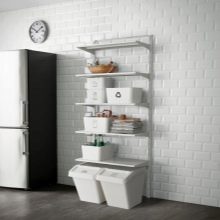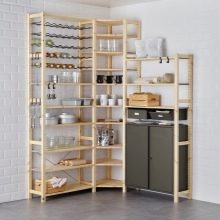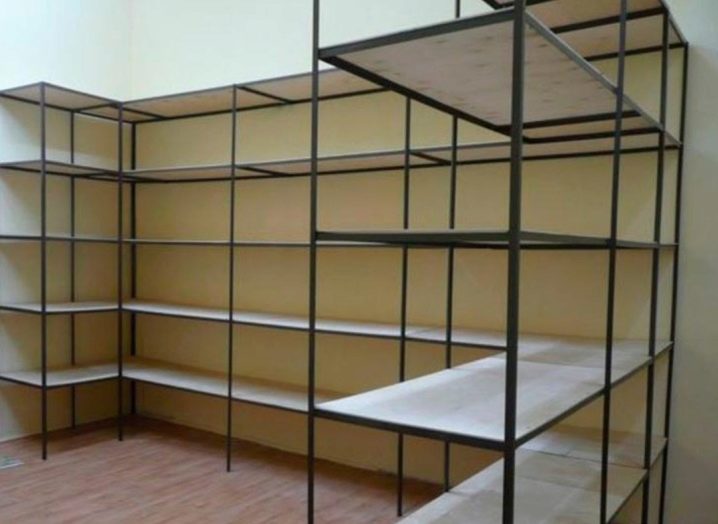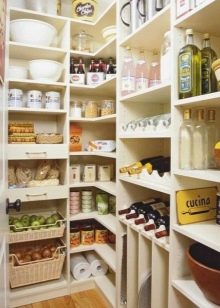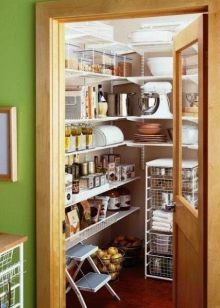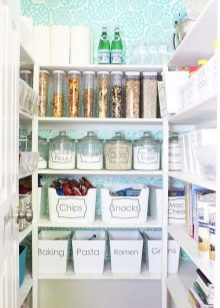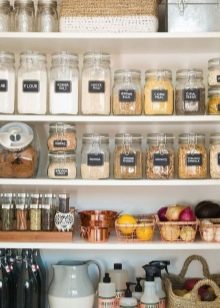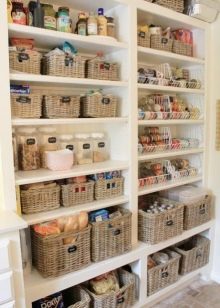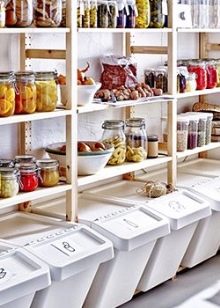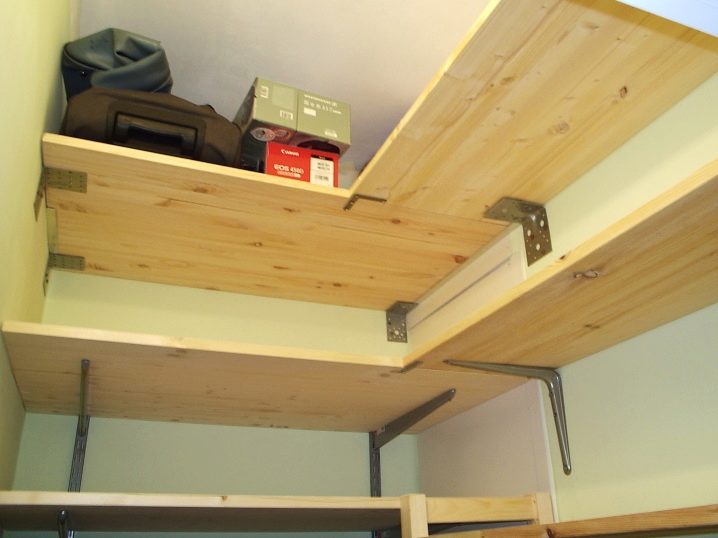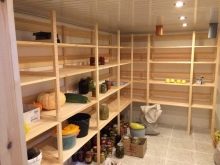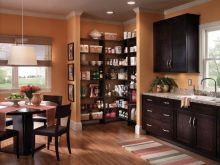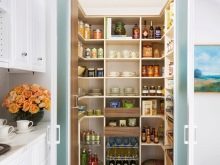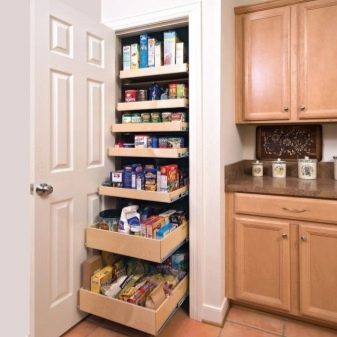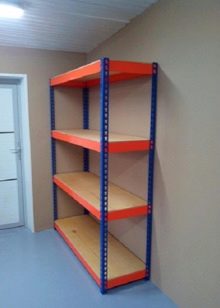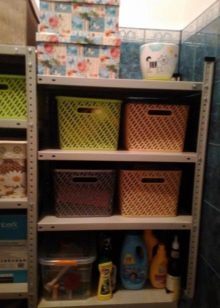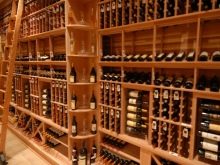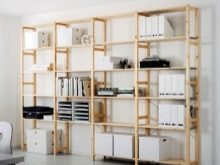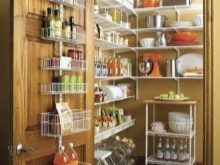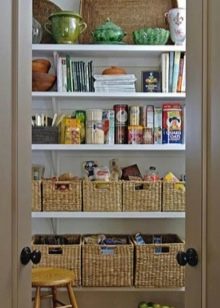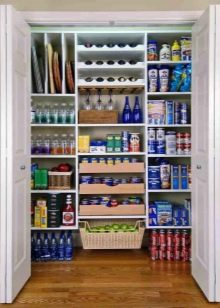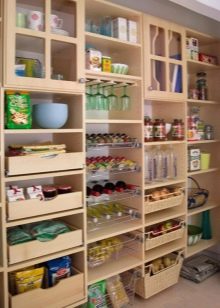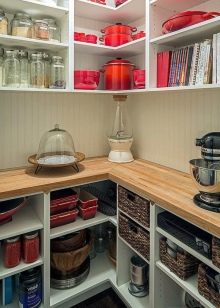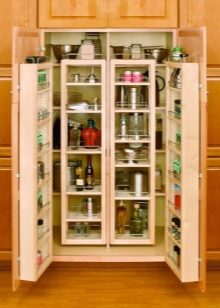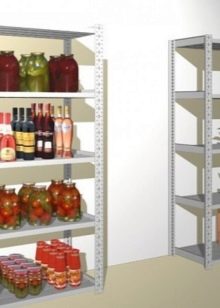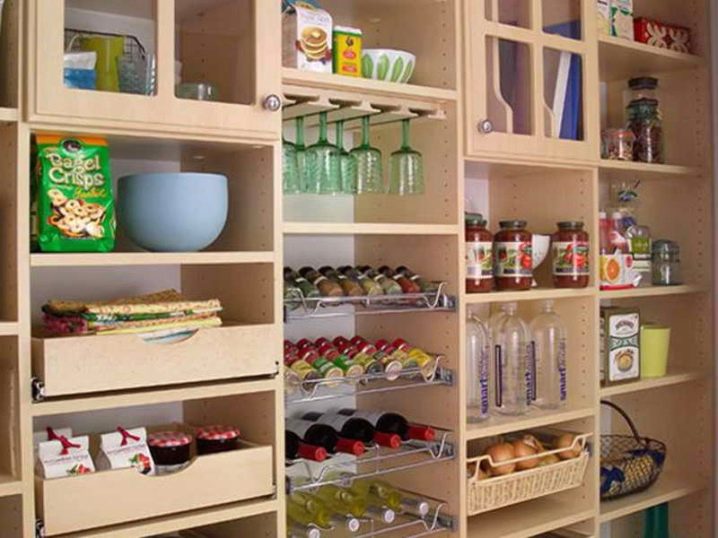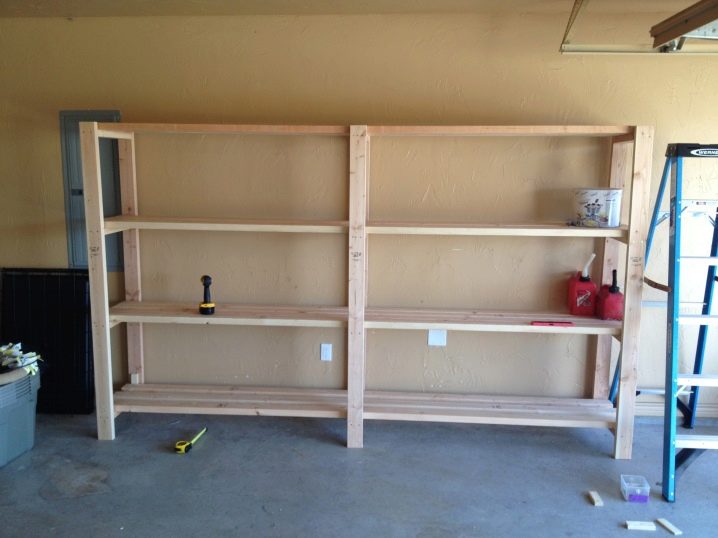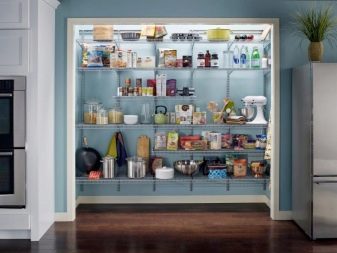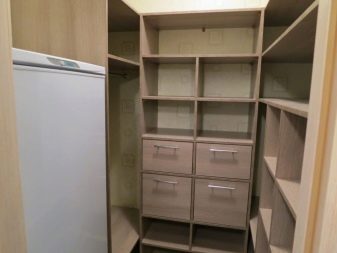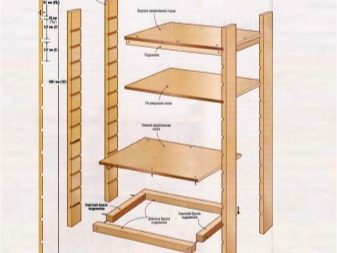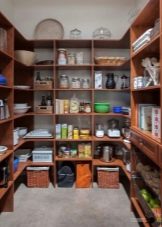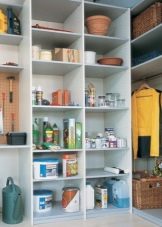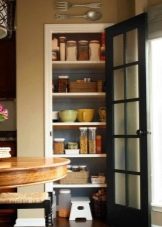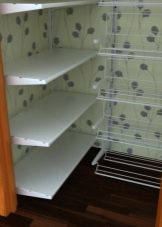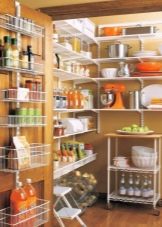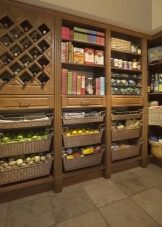Choosing shelves in the pantry
In a space that is limited to a minimum, you will not put massive furniture. Considering the storage room, it is often necessary to limit oneself to a small set of shelves: often you cannot even install a narrow cabinet in it. To use the area as correctly as possible, you can put a rack in the closet. We understand the intricacies of choice.
Special features
The rack is a set of shelves united by a common box. Varieties for the pantry have compact dimensions. This approach is convenient because with a small occupied place the rack allows you to fit a lot of things, freeing them from the apparent space of the apartment. Such furniture was appreciated by many: the rack in the pantry is a convenient storage of food, dishes, home preservation.
This piece of furniture is convenient clear organization. Each regiment of such a rack is used to the maximum and allows you to easily find the desired item, saving time in searching. It has almost everything in sight. The box can be open on both sides or have a back wall.
The openness of such furniture is its main drawback. Due to the fact that the shelves do not close, dust sits on the surface of the rack and its contents. Other disadvantages include the ill-conceivedness of some structures, for example, sometimes the manufacturer provides for roller model legs for creative models, which is completely out of place for using the rack in the closet. You have to choose between compact size and an unnecessary function.
The color of the product may be different. More often it depends on what is offered in the store. These are shades of wood or white and light gray.
If necessary, the rack can be painted: it helps to prolong the life of the material and allows the product to look in a small space most harmoniously.
Materials
Despite the large range of materials used in the manufacture of pantry shelves,priority is only the most reliable. This is due to the fact that each shelf must withstand heavy objects. Therefore, glass as a crossbar and facade is undesirable. It is preferable to buy wooden and metal structures. They are durable, not subject to subsidence under the weight of objects, if the weight of things is in the normal range.
Often, buyers prefer wood derivativebuying fiberboard and particleboard structures. Such raw materials are not designed for continuous operation. On average, it lasts no more than 5-7 years of service with a relatively small workload. It is significantly inferior to analogs of metal, more susceptible to damage due to random mechanical shock.
As a practical option, some companies offer to the attention of the buyer a combined model of wood, grooved boards and iron materials. At home in the course goes all that is at hand. The master can make a rack of plywood, wood, metal.
Each type of material is subject to the features of operation. If shelving is needed for storing conservation, wood is needed.If it is shelves for bulk products, MDF, chipboard is suitable. When the pantry is used as a storage area for tools, metal frame and durable metal shelves are indispensable. Sometimes for the manufacture of shelving using plastic.
Types of designs
The whole range of products offered for sale can be divided into 2 types: a linear rack and a corner version. The storage system can be very different. It depends on the parameters of the storage room itself.
In most cases, it is the design features of the pantry that are the main criterion for selection: the rack must exactly fit in a small space. Therefore, each shelf model is important.
The sizes of shelves and the rack can be different. It depends on the model of the manufacturer and the needs of the buyer. Today, racks can have two to four closed draw-out drawers or closing doors. It resembles a display cabinet with the difference that an insignificant part of the shelves is closed in it.
The most modern designs, in addition to general shelves, can have:
- open shelves with draw-out drawers;
- compartments for cans of different heights;
- closed glass cases;
- shelves with roll-out baskets for storing onions, apples;
- compartments with metal mounts for wine, seasoning, spices;
- low shelves for small things;
- office under the top (working) clothes;
- boxes for potatoes.
In order to freely circulate air in the space, manufacturers produce models with a free lower part and high legs. There is enough space at the bottom to take it, if necessary, under the basket, shopping bag or a small box. Adjustable shelves attract attention: it allows you to change the height, if required by the size of the stored object.
Often in arrangement use wall prefabricated varieties, fixing the rack to the wall. In this case, you need to understand that the filling model can not be solid. You can fill it with different objects, for example, use space for laundry, bulk products, without tamping down each shelf.
Worthy of attention is the built-in species. Such racks are similar to shelves with or without drawers, recessed in a deep niche with a door. Models are interesting because, in fact, are collapsible designer.
If desired, the boxes can be removed, freeing up space for more necessary purposes.
Manufacturers Overview
Modern furniture market is filled with a mass of proposals. Among the wide range of companies whose products are most frequently discussed are:
- "Acapari" - metal structures with predominantly four shelves without compartments and stable supports having different heights of the legs.
- "Dimax" - universal designs of economy class with 3, 4, 5 shelves in one row.
- "Promet" - metal racks, especially strong in terms of weight, with each shelf capable of supporting up to 500 kg per place.
- Eco Forest - laconic designs in one and two rows with shelves on the same level, made of needles.
- "Prospector" - models for vegetables, wines, designs of varying degrees of complexity (up to transformable, equipped with the ability to adjust the angle of inclination).
- Ikea - ready-made factory racks of various modifications of independent and wall type, made of wood and metal.
How to choose?
The choice of the rack is a solid occupation. If at purchase to make a start from external characteristics, the product can not fit into the storeroom or clutter up all its space.
To simplify the selection process will help a few recommendations:
- Before you go to the store, take measurements of the room and the place where the shelving will be located. Take into account the possible height and depth.
- Thin metal plates are not suitable as crossbars; exclude such models from the selection list.
- Do not rely on models with wheels: such varieties are not suitable for the pantry.
- If possible, take an option in which there are closed shelves and draw-out drawers: this will save objects from falling if they are accidentally grazed.
- Prefer models with the presence of baskets and metal systems: shelving is the great advantage of such products.
- Between design and creative, give preference to practicality: it’s good if there is a height adjustment function in the rack.
- Check each withdrawable box for freedom of mechanism: a marriage with time may shatter the design of the box.
Consider another nuance: the rack is not a storehouse of trash: everything in it is strictly delimited and there is no extra space. Start from functionality and purpose.
The depth must be sufficient so that the objects do not hang out, this can cause injury to users.The location of the rack is important: pick up the desired wall so that when you open the door it is convenient to reach all the items on the shelves.
How to make yourself?
Making a shelving with your own hands does not require special skills. Today, if you wish, you can do anything, armed with simple and accessible instructions. Metal collapsible structures and varieties using laminated chipboard are most demanded by home craftsmen. Initially, they make a sketch of the model, depending on the type of pantry, choosing a linear, angular or U-shaped model of the rack.
From tools you may need:
- saw (electric jigsaw);
- screwdriver with linear and cross-shaped profile;
- hammer;
- building roulette;
- screwdriver;
- nails (screws).
The principle of creation is based on the weight of the material: it is preferable to fix lightweight structures to the wall, massive products should stand on the floor. In the process of creating a sketch, estimate the width of the shelf (50-55 cm is enough), the height of the compartments for different plastic or cardboard boxes. You can take care of additional mounting of the rack to the wall with metal ears andself-tapping screws.
Performing a small rack mounted on the wall, you can rely on simple instructions. As a basis, you can take the proposed drawing, which clearly explains the process of manufacturing the structure. You can use wood for supports, laminated chipboard for shelves.
Production stages:
- In long uneven support poles of identical size, we make through grooves on one side at regular intervals (this will be the shelf height adjustment system).
- The height of the supports should be about 2 m. In this case, the grooves are made approximately at a distance of 127-130 mm. The width of the recesses is 20 mm.
- For the bottom and top perform subframes: for each of them they knock together 4 bars of wood, covering with a sheet of plywood, carrying out the upper and lower shelves, by means of which the rack will be held.
- It will remain to cut the sheets of plywood of the desired size and paste them at the right level. The number of shelves may be any, but not too large.
- Such a rack can not be mounted on the wall: due to the strong supports it will be stably placed on the floor. If necessary, it can be removed or moved.
- To give the product an attractive appearance, it can be painted to match the walls or just be lacquered: it will save material from moisture and dampness.
If a sheet of fiberboard is available, it is possible to impart greater reliability to the structure by sheeting it on one side with a single sheet of material with the help of nails.
Stylish examples in the interior
To assess the capacity of the rack for the pantry, you can pay attention to the examples presented in the photo gallery:
- U-shaped shelving fits well into the allotted space, allowing you to locate a maximum of kitchen and household items, including products.
- Two linear shelves are connected to each other, arranging in the storeroom a place to store construction tools and work clothes.
- If a pantry has less than a meter of space, it is enough to build shelves, giving the space a clear organization.
- The original model with a functional angle will appeal to many: due to the use of round-shaped platforms, it allows placing a mass of small objects on planes.
- The rack fixed on the wall is convenient: there is space for extra drawers and boxes at the bottom, as well as shoes that are not needed this season.
- Shelving with shelves mounted on the wall, complemented by a metal structure for lightweight objects.
- A rack in the form of draw-out drawers allows you to use a miniature storage room space: each drawer holds a lot of objects, having them arranged according to their intended purpose.
- You can clearly distinguish between the purpose of each wall of the pantry, even using the door: dishes on one wall are appropriate, and food on the other. You can supplement the design with a metal stool for easy removal of objects from the upper shelves.
How to make a rack with your own hands, see the next video.


